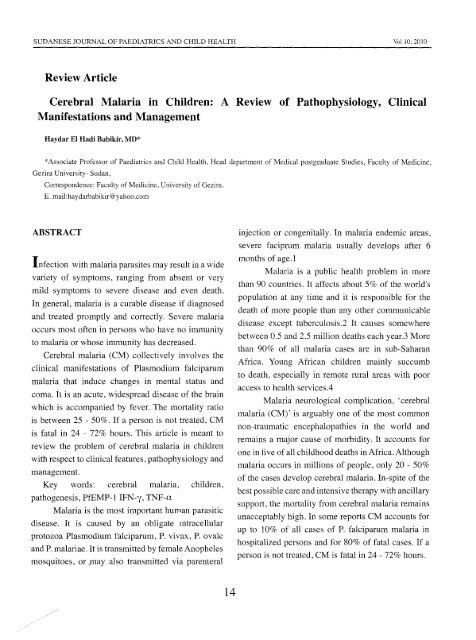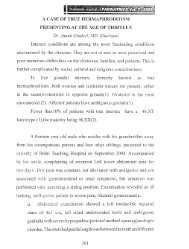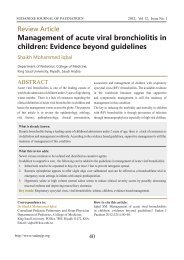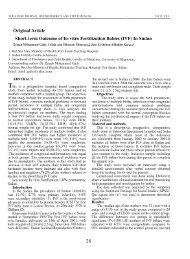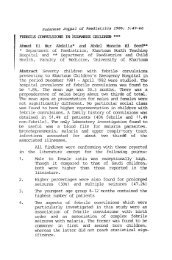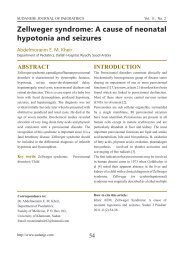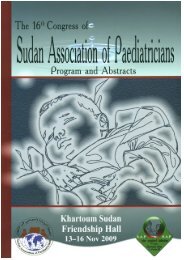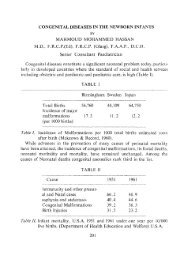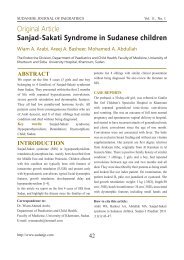Cerebral Malaria in Children: A Review of ... - Sudanjp.org
Cerebral Malaria in Children: A Review of ... - Sudanjp.org
Cerebral Malaria in Children: A Review of ... - Sudanjp.org
Create successful ePaper yourself
Turn your PDF publications into a flip-book with our unique Google optimized e-Paper software.
SUDANESE JOURNAL OF PAEDIATRICS AND CHILD HEALTH Vol 10: 2010<strong>Review</strong> Article<strong>Cerebral</strong> <strong>Malaria</strong> <strong>in</strong> <strong>Children</strong>: A <strong>Review</strong> <strong>of</strong> Pathophysiology, Cl<strong>in</strong>icalManifestations and ManagementHaydar EI Hadi Babikir, MD**Associate Pr<strong>of</strong>essor <strong>of</strong> Paediatrics and Child Health, Head department <strong>of</strong> Medical postgraduate Studies, Faculty <strong>of</strong> Medic<strong>in</strong>e,Gezira University- Sudan,Correspondence: Faculty <strong>of</strong> Medic<strong>in</strong>e, University <strong>of</strong> Gezira.E. mail:haydarbabikir@yahoo.comABSTRACTInfection with malaria parasites may result <strong>in</strong> a widevariety <strong>of</strong> symptoms, rang<strong>in</strong>g from absent or verymild symptoms to severe disease and even death.In general, malaria is a curable disease if diagnosedand treated promptly and correctly. Severe malariaoccurs most <strong>of</strong>ten <strong>in</strong> persons who have no immunityto malaria or whose immunity has decreased.<strong>Cerebral</strong> malaria (CM) collectively <strong>in</strong>volves thecl<strong>in</strong>ical manifestations <strong>of</strong> Plasmodium falciparummalaria that <strong>in</strong>duce changes <strong>in</strong> mental status andcoma. It is an acute, widespread disease <strong>of</strong> the bra<strong>in</strong>which is accompanied by fever. The mortality ratiois between 25 - 50%. If a person is not treated, CMis fatal <strong>in</strong> 24 - 72% hours. This article is meant toreview the problem <strong>of</strong> cerebral malaria <strong>in</strong> childrenwith respect to cl<strong>in</strong>ical features, pathophysiology andmanagement.Key words: cerebral malaria, children,pathogenesis, PfEMP-1 IFN-y, TNF-a<strong>Malaria</strong> is the most important human parasiticdisease. It is caused by an obligate Intracellularprotozoa Plasmodium falciparum, P. vivax, P. ovaleand P. malariae. It is transmitted by female Anophelesmosquitoes, or .may also transmitted via parenteral<strong>in</strong>jection or congenitally. In malaria endemic areas,severe faciprum malaria usually develops after 6months <strong>of</strong> age.1<strong>Malaria</strong> is a public health problem <strong>in</strong> morethan 90 countries. It affects about 5% <strong>of</strong> the world'spopulation at any time and it is responsible for thedeath <strong>of</strong> more people than any other communicabledisease except tuberculosis.2 It causes somewherebetween 0.5 and 2.5 million deaths each year.3 Morethan 90% <strong>of</strong> all malaria cases are <strong>in</strong> sub-SaharanAfrica. Young African children ma<strong>in</strong>ly succumbto death, especially <strong>in</strong> remote rural areas with pooraccess to health servicesA<strong>Malaria</strong> neurological complication, 'cerebralmalaria (CM), is arguably one <strong>of</strong> the most commonnon-traumatic encephalopathies <strong>in</strong> the world andrema<strong>in</strong>s a major cause <strong>of</strong> morbidity. It accounts forone <strong>in</strong> five <strong>of</strong> all childhood deaths <strong>in</strong> Africa. Althoughmalaria occurs <strong>in</strong> millions <strong>of</strong> people, only 20 - 50%<strong>of</strong> the cases develop cerebral malaria. In-spite <strong>of</strong> thebest possible care and <strong>in</strong>tensive therapy with ancillarysupport, the mortality from cerebral malaria rema<strong>in</strong>sunacceptably high. In some reports CM accounts forup to 10% <strong>of</strong> all cases <strong>of</strong> P. falciparum malaria <strong>in</strong>hospitalized persons and for 80% <strong>of</strong> fatal cases. If aperson is not treated, CM is fatal <strong>in</strong> 24 - 72% hours.14
SUDANESE JOURNAL OF PAEDIATRICS AND CHILD HEALTH VallO: 2010Like most countries <strong>in</strong> sub-Saharan Africa, Sudancarries a heavy malaria disease burden. It ranks highas the one <strong>of</strong> the most endemic country <strong>of</strong> the world.It accounts for 50% <strong>of</strong> malaria cases <strong>in</strong> the EasternMediterranean Region. It is estimated that more than8 million cases and about 35,000 deaths occur peryear. The disease accounts for 20% <strong>of</strong> all hospitaldeaths and the malaria case fatality rate for paediatrichospitals ranges between «515- per cent».5The epidemiological pattern <strong>of</strong> severe malariavaries considerably from that <strong>of</strong> hyperdynamic regions<strong>in</strong> sub-Saharan Africa and there is considerablevariation between the <strong>in</strong>dividual complications <strong>of</strong>severe malaria.6Severe <strong>Malaria</strong>Severe malaria occurs when P. falciparum<strong>in</strong>fections are complicated by serious <strong>org</strong>an failuresor abnormalities. It is usually manifests <strong>in</strong> Africanchildren grow<strong>in</strong>g up <strong>in</strong> malarious endemic areas.7Many factors thought to contribute to P. falciparumvirulence these <strong>in</strong>clude:-a- The Redundancy and multiplicative Capacity<strong>of</strong> P. falciparumP. falciparum is able to <strong>in</strong>fect the entirepolymorphic human population; this is due to variantsurface antigens such as Plasmodium falciparumerythrocyte membrane prote<strong>in</strong>-I (PfEMP I) whichspecifically b<strong>in</strong>ds to adhesion molecule CD36 andthrombospond<strong>in</strong> which assists the parasite adherenceto various receptors and removal from the circulationavoid<strong>in</strong>g the snlenic clearance.8b- Parasitized RBCs Membrane Modification:These <strong>in</strong>cludefor mation <strong>of</strong> knob-like structurescomposed <strong>of</strong> prote<strong>in</strong>s (PfEMP-l), protrud<strong>in</strong>g fromtheir surfaces <strong>in</strong>creas<strong>in</strong>g cell wall rigidity and alter<strong>in</strong>gthe metabolites transport. 9c- Cyto-adherence and sequestration <strong>of</strong> parasitizederythrocytes. This is a specific <strong>in</strong>teraction betweenRBCs and the vascular endothelium lead<strong>in</strong>g tosequestration <strong>of</strong> parasitized RBCs <strong>in</strong> deep <strong>org</strong>anspredom<strong>in</strong>antly <strong>in</strong> the bra<strong>in</strong>, heart, lungs and submucosa<strong>of</strong> the small <strong>in</strong>test<strong>in</strong>e.10d- Rosett<strong>in</strong>g and Agglut<strong>in</strong>ation;e- RBC Deformability: In severe malaria bothparasitized (PRBCs) and non-parasitized RBCs(NPRBCs) become rigid due to oxidative damage tothe RBCs compris<strong>in</strong>g their flow through capillaries.This has strong predictive value for fatal outcome.I IThe polymorphism <strong>of</strong> genes cod<strong>in</strong>g four humanadhesion molecules; <strong>in</strong>tercellular adhesion molecule-l(ICAM-I), endothelial select<strong>in</strong> (E-selection), CD36are important variable <strong>in</strong> the susceptibility to severemalaria.12The manifestations <strong>of</strong> severe malaria <strong>in</strong>cludeamong others; cerebral malaria with abnormalbehaviour, impairment <strong>of</strong> consciousness, seizures,coma or other neurologic abnormalities and metabolicacidosis present<strong>in</strong>g as respiratory distress or severeanaemia. Compared with adults, children have ahigher <strong>in</strong>cidence <strong>of</strong> seizures.12The <strong>in</strong>cidence andpattern <strong>of</strong> neurological complications are differentand the patients <strong>of</strong>ten die with features <strong>of</strong> bra<strong>in</strong>death. African children rarely develop renal failure orpulmonary oedema.13<strong>Cerebral</strong> malaria (CM)There is a clear need for a strict def<strong>in</strong>ition <strong>of</strong>cerebral malaria <strong>in</strong> order to properly diagnose andassess the condition. The term «cerebral malaria»<strong>of</strong>ten been loosely used <strong>in</strong> the medical literature todescribe any disturbance <strong>of</strong> the CNS <strong>in</strong> a malaria<strong>in</strong>fection. CM collectively <strong>in</strong>volves the cl<strong>in</strong>icalmanifestations <strong>of</strong> P. falciparum malaria that <strong>in</strong>duceschanges <strong>in</strong> mental status and coma.13, CM hence,is an acute widespread disease <strong>of</strong> the bra<strong>in</strong> which isaccompanied by fever.In older children CM can be def<strong>in</strong>ed as <strong>in</strong> adults.15
SUDANESE JOURNAL OF PAEDIATRICS AND CHILD HEALTH Vol 10: 2010The Blantyre Coma Scale, a related diagnostic tool,has been used for young children 10 years <strong>of</strong> age orless.14,l5 It was devised to assess young childrenresponses (Table 1). However, there is considerabledisagreement between observers <strong>in</strong> assess<strong>in</strong>g thescale and the scale does not address the <strong>in</strong>ability <strong>of</strong>Table: 1 Blantyre and Glasgow Coma Scales.Blantyre coma Scale(Molynux et al.1989)Galsgow Coma scale(Teasdale & Jennett, 1974)Verbal2. Appropriate cry1. Inappropriate cry or moano. No cryvocalization.5. Able to give name and age4. Recognizable and relevant words3. Incomprehensible, but complex2. Cry or grunt1. No responseMotor2. Localizes pa<strong>in</strong>.1. Withdrawal from pa<strong>in</strong>O. Non-specific or no response to pa<strong>in</strong>6. Obeys commands5. Localizes pa<strong>in</strong>.4. Withdrawal from pa<strong>in</strong>.3. Flexes to pa<strong>in</strong>2. Extends to pa<strong>in</strong>.1. No response.Eye1. Directed eye movementsO. Not directed4. Spontaneous eye open<strong>in</strong>g3. Opens eyes to voice2. Opens eyes to pa<strong>in</strong>1. No eye open<strong>in</strong>gwith severe malaria and a summated score <strong>of</strong> 2 isused to def<strong>in</strong>e cerebral malaria <strong>in</strong> many studies.15The Blantyre coma scale has similar componentsto the Glasgow coma scale but it measures differentyoung <strong>in</strong>fants to localize a pa<strong>in</strong>ful stimulus.16A Glasgow coma scale less than 8 has beenproposed as part <strong>of</strong> the def<strong>in</strong>ition <strong>of</strong> CM .16A practicaldef<strong>in</strong>ition based on the Glasgow Coma Score exists.17Its key elements are;16
SUDANESE JOURNAL OF PAEDIATRICS AND CHILD HEALTH VallO: 2010(1) Unrousable coma- No localiz<strong>in</strong>g response to pa<strong>in</strong>persist<strong>in</strong>ghas experiencedfor more than six hours if the patienta generalized convulsion.(2) Asexual forms <strong>of</strong> P. falciparum found <strong>in</strong> bloodand(2) Exclusion <strong>of</strong> othercauses <strong>of</strong> encephalopathy, i.e.viral or bacterial.Pathophysiology<strong>of</strong> <strong>Cerebral</strong> <strong>Malaria</strong><strong>Cerebral</strong> malaria causes and pathophysiology isnot well identified. To <strong>in</strong>vestigatethe pathogenesis<strong>of</strong> CM, several animal models have been established<strong>in</strong> which animals are <strong>in</strong>fected with parasitized RBCsby various types <strong>of</strong> Plasmodium. Although theseanimal models do not exactly reproducethe humandisease, they nevertheless exhibit some similarities tohuman CM such as cl<strong>in</strong>ical signs <strong>of</strong> nervous systemdysfunction and cerebral pathology. 18Infected RBCs become structurally andantigenic ally modified as a consequence <strong>of</strong><strong>in</strong>tracellular parasite development. Parasite encodedprote<strong>in</strong>s such as histid<strong>in</strong>e-rich prote<strong>in</strong>s-I give riseto RBC surface antigen.I9These prote<strong>in</strong>s l<strong>in</strong>k tocells surface produce knobby protrusions. Theoccurrence and severity <strong>of</strong> these early changes <strong>in</strong>the microcirculation correlated with the subsequentdevelopment <strong>of</strong> cerebral symptoms.20 ,21The histopathological hallmark <strong>of</strong> malariaencephalopathy is the sequestration <strong>of</strong> cerebralcapillaries and venules with parasitized red bloodcells and non-PRBCs.22Monocyte marg<strong>in</strong>ationappeared to be the mostsignificant factor associated with the developmentcerebral symptoms. R<strong>in</strong>g-like lesions <strong>in</strong> the bra<strong>in</strong> aremajor characteristics.<strong>of</strong>The leukcocyte sequestration <strong>in</strong>human CM at least <strong>in</strong> paediatric patients is now wellsubstantiated, this agrees with mur<strong>in</strong>e CM animalmodels.23Currently, there are two major hypothesesexpla<strong>in</strong><strong>in</strong>gCM aetiology, these are the mechanicaland the humoral hypotheses.24i- The mechanical hypothesis: The underly<strong>in</strong>gdefect seems to be block<strong>in</strong>g <strong>of</strong> the cerebralmicrocirculations by the parasitized RBCs. Thesecells develop knobs on their surface <strong>in</strong>creas<strong>in</strong>gtheir cytoadherence properties as a result; theytend to adhere to the endothelium <strong>of</strong> capillaries andvenules.25This<strong>in</strong> the deeper blood vessels.leads to sequestration <strong>of</strong> the parasitesThe mechanical hypothesis asserts that a specific<strong>in</strong>teraction between a P. falciparum PtEMP-I andligands on endothelial cells, such as ICAM-l orE-select<strong>in</strong>, reduces microvascular blood flow and<strong>in</strong>duces hypoxia.26 Sequestration <strong>of</strong> P. falciparum<strong>in</strong>fected erythrocytes III post-capillary bra<strong>in</strong>endothelium is <strong>in</strong>duced by immune response onvascular receptors such as CD36. The degree <strong>of</strong>b<strong>in</strong>d<strong>in</strong>g to CD36 is correlated with biochemical<strong>in</strong>dicators <strong>of</strong> disease severity. Other receptors suchas <strong>in</strong>tracellular adhesion molecule-I (l CAM -1),E-select<strong>in</strong> and <strong>in</strong>ducible nitric oxide synthase(iNOS) significantly reduce the RBCs cytoadherencewith <strong>in</strong>creased expressionpatients with cerebral malaria.27<strong>in</strong> the cerebral vessels <strong>of</strong>Rosett<strong>in</strong>g is associated with severe malaria <strong>in</strong>African children.28 Rosett<strong>in</strong>g <strong>of</strong> the parasitizedand non-parasitized red cells and decreaseddeformability <strong>of</strong> the <strong>in</strong>fected red cells further<strong>in</strong>creases the obstruction <strong>of</strong> the microcirculation. Ithas been observed that the adhesiveness is greaterwith the mature parasites. Rosett<strong>in</strong>g thus, accountsvery well for CM histopathological hallmark andits characteristic coma condition. However, thishypothesis is <strong>in</strong>adequate to expla<strong>in</strong> the relativeabsence <strong>of</strong> neurological deficit even after days <strong>of</strong>coma.28Petechial haemorrhage <strong>in</strong>to the bra<strong>in</strong> <strong>in</strong>dicatesthat, bra<strong>in</strong> vasculature<strong>in</strong> patients with P. falciparummalaria is <strong>of</strong>ten damaged. Several studies us<strong>in</strong>g dyeextrusion <strong>in</strong>to tissue have documentedthat vascularpermeability is markedly <strong>in</strong>creased <strong>in</strong> the bra<strong>in</strong>.2917
SUDANESE JOURNAL OF PAEDIATRICS AND CHILD HEALTH VallO: 2010However, the exact contribution <strong>of</strong> vascular leakageto human CM is still not def<strong>in</strong>ed and no significantvascular leakage was detected <strong>in</strong>to bra<strong>in</strong>s <strong>of</strong> patientswith severe P. falciparum malaria.30No def<strong>in</strong>ite evidence <strong>of</strong> cerebral oedema has beenfound on imag<strong>in</strong>g studies. 80% children with CMhave raised <strong>in</strong>tracranial pressure due to <strong>in</strong>creasedcerebral blood volume and biomass rather than<strong>in</strong>creased permeability.Animal models <strong>in</strong> susceptible mice <strong>in</strong>fected withP. berghei develop neurological abnormalities 6 daysafter <strong>in</strong>jection with parasite.31 These mice exhibitbra<strong>in</strong> edema, petechial haemorrhages and monocyte<strong>in</strong>filtration. In addition, <strong>in</strong>jection <strong>of</strong> P. berghei<strong>in</strong>fectedmice with folic acid results <strong>in</strong> convulsions,<strong>in</strong>dicat<strong>in</strong>g that folic acid has crossed the normallyimpermeable blood-bra<strong>in</strong> barrier and is mediat<strong>in</strong>galtered bra<strong>in</strong> signal<strong>in</strong>g.32ii- The humoral hypothesis: This hypothesissuggests that a malarial tox<strong>in</strong> may be released thatstimulates macrophages to release tumor necrosisfactor TNF-a and other cytok<strong>in</strong>es such as IL-1.33The cytok<strong>in</strong>es themselves are not harmful but theymay <strong>in</strong>duce additional and uncontrolled production<strong>of</strong> nitric oxide. Nitric oxide would diffuse throughthe blood-bra<strong>in</strong> barrier and impose similar changeson synaptic function as do general anesthetics andhigh concentrations <strong>of</strong> ethanol lead<strong>in</strong>g to a state <strong>of</strong>reduced consciousness. The biochemical nature <strong>of</strong>this <strong>in</strong>teraction would expla<strong>in</strong> the reversibility <strong>of</strong>coma.34Tumor necrosis factor and gamma <strong>in</strong>terferon(IFN- y) were shown to be important mediators <strong>in</strong> thepathogenesis <strong>of</strong> CM. Second, helper T lymphocytesplaya significant role <strong>in</strong> the development <strong>of</strong> mur<strong>in</strong>eCM.23The role <strong>of</strong> IFN-y and its receptor <strong>in</strong> eMGamma <strong>in</strong>terferon IFN-y is produced <strong>in</strong>abundance dur<strong>in</strong>g cl<strong>in</strong>ical episodes <strong>of</strong> malaria.35The role <strong>of</strong> IFN -y <strong>in</strong> the pathology <strong>of</strong> malariadisease was demonstrated by mur<strong>in</strong>e model <strong>of</strong> CM<strong>in</strong> which disruption <strong>of</strong> <strong>in</strong>terferon gamma receptor1 gene (IFNGR 1) was protective aga<strong>in</strong>st cerebralcomplications <strong>of</strong> P. berghei.36Pathogenic Role <strong>of</strong> TNFR2Previous results suggested that TNF is a keyelement <strong>in</strong> the pathogenesis <strong>of</strong> experimental CM. Highlevels <strong>of</strong> this cytok<strong>in</strong>e is noticed <strong>in</strong> the serum at thetime <strong>of</strong> CM. More recently, additional confirmation <strong>of</strong>the pathogenic role <strong>of</strong> TNF <strong>in</strong> CM has been provided<strong>in</strong> experiments with transgenic mice express<strong>in</strong>g highlevels <strong>of</strong>TNF receptor 1 (TNFRl).37 The <strong>in</strong>teractionbetween membrane TNF and TNFR2 is crucial tothe development <strong>of</strong> the neurological syndrome seen<strong>in</strong> severe malaria.38 More recently, TNFR2 wasshown to be important <strong>in</strong> endothelial cell apoptosis<strong>in</strong> the absence <strong>of</strong> sensitiz<strong>in</strong>g agents, i.e., underpathophysiologically relevant condition.39The receptor <strong>in</strong>volved <strong>in</strong> the parasite-<strong>in</strong>ducedmonocyte and macrophage stimulation has not beencharacterized. <strong>Malaria</strong> tox<strong>in</strong>s are important moleculesthat are responsible for the direct <strong>in</strong>duction by theparasite <strong>of</strong>TNF secretion by host monocytesAOPlatelet-Endothelial Interactions <strong>in</strong> MicrovascularPathology beyond <strong>Cerebral</strong> <strong>Malaria</strong>: The effects <strong>of</strong>anti-LFA-l monoclonal antibody (anti-LFA-IMAb)on CM and on platelet accumulation <strong>in</strong> bra<strong>in</strong> vesselsmay <strong>of</strong>fer <strong>in</strong>sight <strong>in</strong>to the mechanism <strong>of</strong> action <strong>of</strong>this antibody <strong>in</strong> vivo. Apart from their beneficial role<strong>in</strong> haemostasis, platelets also <strong>in</strong> vitro experimentswith human cells have <strong>in</strong>dicated a role for LFA-l<strong>in</strong> platelet-endothelium <strong>in</strong>teractions, substantiatedthe fusion phenomenon and confirmed that plateletscan potentiate the TNF-<strong>in</strong>duced endothelial kill<strong>in</strong>g.A pathogenic role for platelets is also suspected <strong>in</strong>disorders other than CM, such as gram-negativebacterial septic shock, acute respiratory distresssyndrome, vasculitides pulmonary fibrosis, tumor18
SUDANESE JOURNAL OF PAEDIATRICS AND CHILD HEALTH VallO: 2010metastasis, transplant rejection, stroke, bra<strong>in</strong> hypoxiaand related conditions. Indeed, platelets have beendetected dur<strong>in</strong>g rejection episodes41InvolvementTumor necrosis<strong>of</strong> Cell Adhesion Moleculesfactor can <strong>in</strong>duce or upregulatevarious cell adhesion molecules(CAM)on endothelialcells; the expression <strong>of</strong> these molecules was analyzedby immunohistochemistry.with CM showed a marked upregulationBra<strong>in</strong> vessels from mice<strong>of</strong> ICAM-1and vascular cell adhesion molecule 1(VCAM-1).42An attempt to prevent CM by <strong>in</strong>travenous<strong>in</strong>jection <strong>of</strong> anti-TNF monoclonalantibodies(MAbs)directed aga<strong>in</strong>st LFA-1, Mac-I, ICAM-I, VCAM-I,VLA-4 and P-select<strong>in</strong>;MAb proved to be efficient.showed that only anti-LFA-1The important role <strong>of</strong>ICAM -1 was confirmed us<strong>in</strong>g a SCID mouse model<strong>in</strong> which P. falciparum-<strong>in</strong>fectedto bra<strong>in</strong> ICAM-Ideficient mice.43human RBC adhereand more recently us<strong>in</strong>g ICAM-1-An adhesion molecule CD36 also known asplatelet glycoprote<strong>in</strong> IV or IIIb, is an 88 kDamembrane prote<strong>in</strong> expressed on the surface asmulti-ligandreceptor <strong>of</strong> a wide variety <strong>of</strong> cell typessuch as platelets, endothelial cells, monocytes andmacrophages. It is <strong>in</strong>volved <strong>in</strong> host defense aga<strong>in</strong>st P.falciparum. CD36 is commonly deficient, particularly<strong>in</strong> certa<strong>in</strong> ethnic groups <strong>in</strong>clud<strong>in</strong>g Africans. Its role <strong>in</strong>CM is debatable.44Obstruction to the cerebral microcirculationresults<strong>in</strong> hypoxia and <strong>in</strong>creased lactate production due toanaerobic glycolysis. The parasitic glycolysis mayalso contribute to lactate production. In patients withCM, C.S.F. lactate levels are high and significantlyhigher <strong>in</strong> fatal cases than <strong>in</strong> survivors. The adherenterythrocytes may also <strong>in</strong>terfere with gas and substrateexchange throughout the bra<strong>in</strong>. However, completeobstruction to blood flow is unlikely, s<strong>in</strong>ce thesurvivors rarely have any permanent neurologicaldeficit.The mechanism<strong>of</strong> coma is not clearly known.Increased cerebral anaerobic glycolysis, <strong>in</strong>terferencewith neurotransmission by sequestered andhighly metabolically active parasites has beenblamed. Cytok<strong>in</strong>es <strong>in</strong>duce a potent <strong>in</strong>hibitor <strong>of</strong>neurotransmission, nitric oxide (NO), synthesis<strong>in</strong> leukocytes, smooth muscle cells, microglia andendothelium.Cl<strong>in</strong>ical Manifestations<strong>Cerebral</strong> malaria is an acute widespread disease <strong>of</strong>the bra<strong>in</strong> which is accompanied by fever. In severe P.falciparum malaria the neurological dysfunction canmanifest suddenly follow<strong>in</strong>g a generalized seizureor gradually over a period <strong>of</strong> hours.46The cl<strong>in</strong>icalmanifestations however, are numerous but there arethree primary symptoms generally common to bothadults and children:(1) Impaired consciousness with non-specific fever,(2) Generalized convulsions and neurologicalsequelae and,(3) Coma that persists for24 -72% hours, <strong>in</strong>itiallyarousable and then unarousable.Neurological Signs <strong>in</strong> <strong>Cerebral</strong> <strong>Malaria</strong>:Mild neck stiffness may be seen, however,neck rigidity and photophobia and signs <strong>of</strong>raised <strong>in</strong>tracranial pressure are absent. Ret<strong>in</strong>alhaemorrhages occur <strong>in</strong> about 15% <strong>of</strong> cases, exudatesare rare. Pupils are normal. Papilloedema is rareand should suggest other possibilities. A variety <strong>of</strong>transient abnormalities <strong>of</strong> eye movements, especiallydysconjugate gaze are observed. Fixed jaw closureand tooth gr<strong>in</strong>d<strong>in</strong>g (bruxism) are common. Pout<strong>in</strong>g orshow<strong>in</strong>g displeasure may occur or may be elicitable,but other primitive reflexes are usually absent. Thecorneal reflexes are preserved except <strong>in</strong> a case <strong>of</strong> deepcoma. Motor abnormalities like decerebrate rigidity,decorticate rigidity and opisthotonus can occur. Deepjerks and plantar reflexes are variable. Abdom<strong>in</strong>aland cremasteric reflexes can not be elicited. Thesesigns help <strong>in</strong> dist<strong>in</strong>guish<strong>in</strong>g CM from behaviouralproblems due to fever <strong>of</strong> other causes. Rarely, cases19
SUDANESE JOURNAL OF PAEDIATRICS AND CHILD HEALTH Vol 10: 2010<strong>of</strong> falciparum malaria may present with cerebellarataxia with unimpaired consciousness. It may evenoccur 34- weeks after an attack <strong>of</strong> falciparum malaria.It completely recovers over 12- weeks.6Management <strong>of</strong> <strong>Cerebral</strong> <strong>Malaria</strong> <strong>in</strong> <strong>Children</strong>Severe malaria is a medical emergency andmay rapidly progress to death without promptand appropriate treatment. The ma<strong>in</strong> objective <strong>of</strong>the treatment <strong>of</strong> severe malaria is to prevent thepatient from dy<strong>in</strong>g; prevention <strong>of</strong> recrudescence,transmission or emergence <strong>of</strong> resistance andprevention <strong>of</strong> disabilities are secondary objectives.Light microscopy <strong>of</strong> well sta<strong>in</strong>ed thick and th<strong>in</strong>films by a skilled microscopist has rema<strong>in</strong>ed the«gold standard» for malaria diagnosis. However,microscopy cannot detect parasite sequestereddeep <strong>in</strong> the vascular compartment and <strong>in</strong> case <strong>of</strong>mixed <strong>in</strong>fection <strong>of</strong>ten one species suppresses theother, thereby mak<strong>in</strong>g detection <strong>of</strong> the suppressedone difficult.ao Blood gases and acid base deficit,renal function pr<strong>of</strong>ile and blood glucose are usefulpredictors <strong>of</strong> the outcomeCerebrosp<strong>in</strong>al fluid analysis may have to bedone <strong>in</strong> all doubtful cases and to rule out associatedmen<strong>in</strong>gitis. In malaria, C.S.F. pressure is normallyelevated, fluid is clear and WBCs are fewer than 10/Jtl; prote<strong>in</strong> and lactic acid levels are elevated.d?Electroencephalogram may show non-specificabnormalities and C.T. scan <strong>of</strong> the bra<strong>in</strong> is usuallynorma1.48 In addition to bra<strong>in</strong> swell<strong>in</strong>g, cortical<strong>in</strong>farcts and white matter lesions can be seen on MRexam<strong>in</strong>ations obta<strong>in</strong>ed dur<strong>in</strong>g the course <strong>of</strong> cerebralmalaria. White matter lesions can regress witheffective treatment. The MR pattern is compatiblewith toxicity lead<strong>in</strong>g to <strong>in</strong>travascular eng<strong>org</strong>ementand oedema and <strong>in</strong> some cases, to irreversible myel<strong>in</strong>damage.49Meticulous nurs<strong>in</strong>g is the most important aspect<strong>of</strong> management <strong>in</strong> patients with CM and coma.A clear airway must be ma<strong>in</strong>ta<strong>in</strong>ed. In cases <strong>of</strong>prolonged deep coma, endotracheal <strong>in</strong>tubation maybe <strong>in</strong>dicated. Naso-gastric aspiration is importantto prevent aspiration pneumonia. Urethral catheterhas to be <strong>in</strong>serted for monitor<strong>in</strong>g ur<strong>in</strong>e output <strong>in</strong> anycomatose patient. All children with cerebral malariashould be admitted to an ICU if possible and childrenwith impend<strong>in</strong>g respiratory failure should be placedon ventilatory support.It is quite helpful to ma<strong>in</strong>ta<strong>in</strong> strict <strong>in</strong>take/outputrecords and to monitor the vital signs every 46-hours.50 Observe for high coloured or black ur<strong>in</strong>e.Changes <strong>in</strong> levels <strong>of</strong> sensorium, occurrence <strong>of</strong>convulsions should also be observed.It is crucial to control or prevent seizures as theycan cause neuronal damage and are associated with afatal outcome. Witnessed seizures are managed withslow diazepam (0.2 mg/kg IV maximum <strong>of</strong> 10 mgor 004 mg/kg per rectum) or paraldehyde (0.1 mL/kg 1M). Because diazepam can worsen respiratorydepression, the patient's respiratory status should bemonitored carefully after diazepam adm<strong>in</strong>istration.Patients with recurrent seizures should be treatedwith Phenobarbital or Phenyto<strong>in</strong>, as one wouldtreat a patient with status epilepticus. Phenobarbitalprophylaxis for seizures is not recommended <strong>in</strong>children with cerebral malaria. Large studies <strong>in</strong>African children demonstrated a higher mortality rate<strong>in</strong> children who received Phenobarbital prophylaxiscompared to controls.51Hypoglycemia is common <strong>in</strong> children below 3years <strong>of</strong> age especially with hyperparasitemia orwith convulsion. It also occurs <strong>in</strong> patients treatedwith qu<strong>in</strong><strong>in</strong>e. Manifestations are similar to those <strong>of</strong>cerebral malaria so it can be easily overlooked. Bloodsugar should be Monitored every 4 to 6 hours.Exchange transfusion generally only beenjustified when peripheral parasitaemia exceeds 10%<strong>of</strong> circulat<strong>in</strong>g erythrocytes. The role <strong>of</strong> these blood20
SUDANESE JOURNAL OF PAEDIATRICS AND CHILD HEALTH VallO: 2010transfusions rema<strong>in</strong>s highly controversial, as they areboth expensive and potentially dangerous <strong>in</strong> manymalaria-endemic areas.Pentoxifyll<strong>in</strong>e helps microcirculatory flowby reduc<strong>in</strong>g the red cell deformability and bloodviscosity, decreases systemic vascular resistanceand impairs platelet aggregation thus improv<strong>in</strong>gmicrocirculatory flow.Desferrioxam<strong>in</strong>e this is an iron-chelat<strong>in</strong>g adjuvantagent with antimalarial properties is suggested as itreduces the formation <strong>of</strong> reactive oxygen species byreduc<strong>in</strong>g amount <strong>of</strong> free iron.52The follow<strong>in</strong>g drugs should not be adm<strong>in</strong>istered:Anti-Inflammatories such as corticosteroids.However, there have been few controlled studiesdemonstrat<strong>in</strong>g benefit. other anti<strong>in</strong>flammatory drugs;low molecular weight dextran; adrenal<strong>in</strong>e; hepar<strong>in</strong>;hyperbaric oxygen; cyclospor<strong>in</strong> should be avoided.Dehydration and hypovolemia <strong>in</strong> children withcerebral malaria should be corrected with <strong>in</strong>travenousfluids or colloid. Lactic acidosis can be correctedby aggressive management <strong>of</strong> malarial <strong>in</strong>fection,volume replacement if the patient is dehydrated andtransfusion <strong>of</strong> blood as appropriate.The mortality <strong>of</strong> untreated severe malaria can be100%, but with antimalarial treatment, the overallmortality falls to 15-20%. As death from severemalaria can occur with<strong>in</strong> hours <strong>of</strong> admission tohospital or cl<strong>in</strong>ic, it is essential that therapeuticconcentrations <strong>of</strong> antimalarial are achieved as soonas possible with <strong>in</strong>travenous antimalarials. Further,gastro<strong>in</strong>test<strong>in</strong>al <strong>in</strong>tolerance and erratic <strong>in</strong>test<strong>in</strong>alabsorption make the oral route <strong>of</strong> adm<strong>in</strong>istrationunreliable <strong>in</strong> these patients. As resistance toantimalarial drugs can complicate matters further,proper choice <strong>of</strong> antimalarials to start the treatmentis <strong>of</strong> utmost importance; chang<strong>in</strong>g the drugs oradd<strong>in</strong>g <strong>of</strong> drugs half-way through the treatment onlycomplicates the issue and adds to the adverse effects<strong>of</strong> treatment. <strong>Children</strong> with cerebral malaria shouldbe treated with <strong>in</strong>travenous or <strong>in</strong>tramuscular Qu<strong>in</strong><strong>in</strong>e,or <strong>in</strong>tramuscular Artemis<strong>in</strong><strong>in</strong> derivatives.53Consequences and Prognosis <strong>of</strong> <strong>Cerebral</strong> <strong>Malaria</strong><strong>Cerebral</strong> malaria carries a mortality <strong>of</strong> around 20%<strong>in</strong> adults and 15% <strong>in</strong> children. Factors associated witha fatal outcome <strong>in</strong>cluded deep breath<strong>in</strong>g or acidosis(base excess below -8), hypotension (systolic bloodpressure < 80mmHg), raised plasma creatn<strong>in</strong>e (>80]tmolll), low oxygen saturation «90%), dehydrationand hypoglycaemia «2.5 mmolll). Approximately7% <strong>of</strong> children who survive CM are left withpermanent neurological problems. These <strong>in</strong>cludeweakness, spasticity, bl<strong>in</strong>dness, speech problemsand epilepsy. Recent evidence suggests that somechildren who appear to have made a completeneurological recovery from cerebral malaria maydevelop significant cognitive problems (attentiondeficits, difficulty with plann<strong>in</strong>g and <strong>in</strong>itiat<strong>in</strong>g tasks,speech and language problems), which can adverselyaffect school performance and persist for years afterthe attack.54 The limited availability <strong>of</strong> specializedcare for such children <strong>in</strong>dicates that opportunitiesfor subsequent learn<strong>in</strong>g and for atta<strong>in</strong>ment <strong>of</strong><strong>in</strong>dependence, are compromised even further.References1- Newton. CR.1nteraction between Plasmodium falciprum andhuman immunodeficiency virus type 1on the central nervoussystem <strong>of</strong> African children.».I Neurovirol 2005; 11 suppl 3:4551-.2--Luhan, M. <strong>Malaria</strong>. WHO Press Office fact sheet 94. P. 1-3.World Health Organization, Geneva, Switzerland. 1996.3- WHO. Current epidemiological situation.TDR Roll Back<strong>Malaria</strong>. Report: 2002.4- Ch<strong>in</strong>, 1. (Ed.) (2000). Control <strong>of</strong> communicable diseasesmanual (17th ed.). Wash<strong>in</strong>gton, DC: American Public HealthAssociation.21
SUDANESE JOURNAL OF PAEDIATRICS AND CHILD HEALTH VallO: 20105- Korenromp E, Williams B, de Vias S, Gouws E, Gilks C, GhysP, Nahlen B. <strong>Malaria</strong> attributable to the HIV-1 epidemic,sub-Saharan Africa. Emerg Infect Dis. 2005; 11 (9): 14109-.6- Giha, H. A., G Elghazali, et al. «Cl<strong>in</strong>ical pattern <strong>of</strong> severeplasmodium malaria <strong>in</strong> Sudan <strong>in</strong> an area characterized byseasonal and unstable malaria transmission.»Trans R SocTrop Med HYG. 2005; 99(4): 24351-.7- World Health Organization. Control <strong>of</strong> tropical disease .Severeand complicated malaria.Trans R Soc Trop Med Hyg 1990;84(SuppI2):165-.8- Rogerson, L., S.M. Potter, et al. The microcirculation <strong>in</strong> severemalaria.Microcirculation 2006; 11(70: 55976-.9- Kirchgatter, E., PJ. McCall, et al. Cl<strong>in</strong>ical and molecularaspects <strong>of</strong> severe malaria. An Acad Bras Cienc. 2006; 77(3):45575-.,10- Montogomery, I., D. A. Milner, Ir., et al Genetic analysis<strong>of</strong> circulat<strong>in</strong>g and sequestered populations <strong>of</strong> Plasmodiumfalciprum <strong>in</strong>fatal paediatric malaria. I Infect Dis. 2006; 194(1): 11522-.11- Dondorp, A. M., E. Pongponratn, et al. Reducedmicrocirculatory flow <strong>in</strong> severe Falciparum malaria:pathophysiology and electron-microscopic pathology. Cell2004; 121(1): 1324-.12- Amodu, OK., R.A. Gbadeges<strong>in</strong>, et al, Psmodium falciparummalaria <strong>in</strong> South-West Nigerian children: Is polymorphism<strong>of</strong> 1CAM-1 and E-selection genes contribut<strong>in</strong>g to the cl<strong>in</strong>icalseverity <strong>of</strong>malaria? Acta Trop 2005; 95(3): 24855-.13- Ozen, M., S. Gungor, et al. <strong>Cerebral</strong> malaria ow<strong>in</strong>g toPlasmodium vivax: case report.» Ann Trop Paediatr 2006;26(2):36474-.14- Teasdale, G. and B. Iennett «Assessment <strong>of</strong> coma andimpaired consciousness. A practical scale .»Lancet 1974; 81-84.15- Newton CRIC, Chokwe T, Schellenberg lA, et al. Comascales for children with severe falciparum malaria. Trans RSoc Trop Med Hyg 1997; 91 :161165-.16- Warrell DA. Treatment and prevention <strong>of</strong> malaria. In: WarrellDA, Giles HM, eds. Essential Maloriology, 4th ed. London:Hodder Arnold, 2002; 270311-.18- Turner, G. <strong>Cerebral</strong> malaria. Bra<strong>in</strong> Pathol 1997; 7:569-582.19- W<strong>in</strong>ograd, E., I .. G. Prudhomme, et al. Band 3 cluster<strong>in</strong>gpromotes the exposure <strong>of</strong> neoantigens <strong>in</strong> Plasmodiumfalciprum-<strong>in</strong>fected erythrocytes» Mol Biochem Parasitol2005; 142(1): 98105-.20- Lopez-Estrano, C. S., Bhattacharjee, et al. Cooperativedoma<strong>in</strong>s def<strong>in</strong>e a unique host cell-target<strong>in</strong>g signal <strong>in</strong>Plasmodium falciparum-<strong>in</strong>fected erythrocytes. Proc NatlAcad Sci 2003; 100 (21): 124027-21- World Health Organization. Severe [alciparum malaria.TransR Soc Trop Med Hyg 2000; 94 (Suppl. 1): Sl-S90.22- Van der Heyde, H. C., I. Nolan, etal. A unified hypothesis forthe genesis <strong>of</strong> cerebral malaria: sequestration, <strong>in</strong>flammationand hemostasis lead<strong>in</strong>gto microcirculatory dysfunction.Trends Parasitol 2006; 22(11): 5038-.23 - Grau, G. E., and S. de Kossodo. <strong>Cerebral</strong> malaria: Mediators,mechanical obstruction or more? Parasitol. Today 1994;10:408-409.24- Van der Heyde, H. C., I. Nolan, et al. A s<strong>in</strong>gle member <strong>of</strong>the plasmodium falciparum var multigene family determ<strong>in</strong>escytoadhesion to the placental receptor chondroit<strong>in</strong> sulphateA.» EMBO Rep 2006; 6(8): 7781-.25- Kirchgatter, E., P. I. McCall, et al. Cl<strong>in</strong>ical and molecularaspects <strong>of</strong> severe malaria.An Acad Bras Cienc 2006; 77(3):45575-.26- Tripathi, A. K., D. J.Sullivan, et all. Plasmodium falciparum<strong>in</strong>fectederythrocytes <strong>in</strong>crease <strong>in</strong>tercellular adhesionmolecule 1 expression on bra<strong>in</strong> endothelium through NFkappaB» Infect 1mmun. 2006; 74(6): 326270-.27- Turner, GD., et. al., An immunohistological study <strong>of</strong>the pathology <strong>of</strong> fatal malaria. Evidence for widespreadendothelial activation and a potential role for <strong>in</strong>tercellularadhesion molecule-1 <strong>in</strong> cerebral sequestration Am. I. Pathol1994;145: 10571069-28- Dean,A. M., I.A. Rowe. Plasmodium jalciparum: Rosettes donot protect merozoites from <strong>in</strong>vasion-<strong>in</strong>hibitory antibodies.Exp Parasitol2006; 112(4): 26973-.29- P<strong>in</strong>o , P., Z. Taoufiq, et al. Blood-bra<strong>in</strong> barrier breakdowndur<strong>in</strong>g cerebral malaria: suicide or murder? Throm Haemost2005; 94(2): 33640-.30- Brown, H. C., T. T. Chau, N. T. Mai, N. P. Day, D. X. S<strong>in</strong>h, N.I. White, T. T. Hien, I. Farrar, and G. D. Turner. Blood-bra<strong>in</strong>barrier function <strong>in</strong> cerebral malaria and CNS <strong>in</strong>fections <strong>in</strong>Vietnam. Neurology 2000; 55:104111-.31- F<strong>in</strong>ley, R. w., L. I. Mackey, and P. H. Lambert. Virulent P.berghei malaria: prolonged survival and decreased cerebral22
SUDANESE JOURNAL OF PAEDIATRICS AND CHILD HEALTH VallO: 2010pathology <strong>in</strong> cell-dependent nude mice. 1. Immunol 1982;129:22132218-32- Hermsen, C. C., E. Mommers, T. van de Wiel, R. W. Sauerwe<strong>in</strong>,and W. M. El<strong>in</strong>g. Convulsionsdue to <strong>in</strong>creased permeability<strong>of</strong> the blood-bra<strong>in</strong> barrier <strong>in</strong> experimental cerebral malariacan be prevented by splenectomy or anti-T cell treatment. 1.Infect. Dis 1998; 178:12251227-.33- Gimenez, F., S. Barraud de Lagerie, et al. Tumor necrosisfactor alpha <strong>in</strong> the pathogenesis <strong>of</strong> cerebral malaria.eCellMol Life Sci 2003; 60(8): 24351-.34- Howard Rl, Uni S, Aikawa M, Aley SB, Leech IH, Lew AN,et al. Secretion <strong>of</strong> a malarial histid<strong>in</strong>e-richprote<strong>in</strong> (Pf HRP-II) from Plasmodium falciparum <strong>in</strong>fected erythrocytes. I Cellbioll986; 103: 12691277-.35- Grau, G. E., H. Heremans, P. F. Piguet, P. Po<strong>in</strong>taire, P. H.Lambert, A. Billiau, and P. vasscdli. Monoclonal antibodyaga<strong>in</strong>st <strong>in</strong>terferongamma can prevent experimental cerebralmalaria and its associated overproduction <strong>of</strong> tumor necrosisfactor. Proc. Natl.Acad. Sci. USA. 1989; 86:5572- 557436- Hunt, N. H. and G. E. Grau. cytok<strong>in</strong>es: accelerators andbrakes <strong>in</strong> the pathogenesis <strong>of</strong> cerebral malariaTrends1mmuno12003; 924: 4919-.37- Amani, v., A. M. M<strong>in</strong>ang, et al. Involvement <strong>of</strong> IFN-gammareceptor-medicated signal<strong>in</strong>g <strong>in</strong> pathology and anti-malarialimmunity <strong>in</strong>duced by Plasmodium berghei <strong>in</strong>fection» Eur IImmunol2000; 30(6): 164655-.38- Garcia, 1., K. Araki, Y Miyazaki, M. Araki, P. Juillard, G. E.Grau, G. Milon, Y Belkaid, C. Mont<strong>in</strong>i, W. Lesslauer, and P.vassalli. Transgenic mice express<strong>in</strong>g soluble TNF-Rl-IgG3molecules are protectedfromlethal septic shock and cerebralmalaria, and are highly sensitive to Listeria monocytogenesand Leishmania major <strong>in</strong>fections. Eur. 1. Immunol 1995;25 :2401-2407.39- Lucas, R., P. luillard, E. Decosters, M. Redard, D. Burger,Y Donati, C. Giroud, C. Monsoh<strong>in</strong>ard, T. Dekesel. W. A.Buurman, M.W. Moore, I.M. Dayer, W. Fiers, H. Bluethmann,and GE.Gran. Curial role <strong>of</strong> tumor necrosis factor (TNF)receptor 2 and membrane-bound TNF <strong>in</strong> exprmental cerebralmalaria.l.NeuroimmunolI993;27:17191725-.40- Lucas, R., I. Garaa, YR.A. Donati, M. Hritar, S. Mandriota,e. Giroud, WA. Buuman, L. Fransen, P.M. Suter, G. Nuuez;M.S, Pepper, and GE. Gran. Both TNF receptors arerequired for direct NF mediated cytotoxcity<strong>in</strong> microvascularendothelial cells. Eur. 1.1mmunol1998; 28:35773586-.41- Kwiatkowski, D. TNF-<strong>in</strong>duc<strong>in</strong>g malaria tox<strong>in</strong>-a sheep <strong>in</strong>wolf's cloth<strong>in</strong>g. Ann. Trop. Med. Parasitol 1993; 87:613-616.42- Koo, D. D., K. 1. Welsh, 1. A. Roake, P. 1. Morris, and S.V. Fuggle .. Ishemia/reperfusion <strong>in</strong>jury <strong>in</strong> human kidneytransplantation: an immunohistochemical analysis <strong>of</strong>changes after reperfusion. Am. 1.Patho11989; 153: 557-566(50).43- Falanga, P. B., and E. C. Butcher. 1991. Late treatment withanti-LFA-1 (CDlJa) antibody prevents cerebral malaria <strong>in</strong> amouse model. Eur. 1. Immunol 21 :2259-2263.44- Mowbray, 1. Platelet thrombi <strong>in</strong> rejection episodes. Proc. R.Soc. Med 1969; 62:597-600. (70).45- Ge, Y and M. T. Elghetany CD36: a multiligand molecule »Lab Hematol2005; ll( 1): 317-.46- Hunt, N.H., GE.Grau. Cytok<strong>in</strong>e: acceleratos and brakes <strong>in</strong>the pathogenesis <strong>of</strong> cerebral malaria. Trends 1mmunol2003;(24): 4919-.47- Houwen B. Blood film preparation and sta<strong>in</strong><strong>in</strong>g procedure.Cl<strong>in</strong> Lab Med 2002; 22:114-.48- WHO. <strong>Malaria</strong> diagnosis: Memorandum from a WHOmeet<strong>in</strong>g. Bull WHO 1988; 66: 575594-.49- WHOIUNICEF. Management <strong>of</strong> Childhood Illness.ChartBooklet. Geneva 1995: World Health Organization, NewYork; United Nations <strong>Children</strong> Fund.50- World Health Organization. Approaches to the Diagnosis<strong>Malaria</strong>. In: New Perspectives <strong>Malaria</strong> Diagnosis. Report <strong>of</strong>a Jo<strong>in</strong>t WHOIUSAID Informal Consultation 2000; 1018-.51- Meremikwu M, Marson AG. Rout<strong>in</strong>e anticonvulsants fortreat<strong>in</strong>g cerebral malaria.Cochrane Database <strong>of</strong> Systematic<strong>Review</strong>s 2002, Issue 2. Art. No.: CD002152. DO!:10.1002146518581.CD002152. April 22. 200252- World Health Organization. Diagnosis <strong>of</strong> <strong>Malaria</strong> <strong>in</strong>Management <strong>of</strong> Severe <strong>Malaria</strong>. A Practical Handbook 2nded. Geneva: WHO 2000; 4648-.53- Gordeuk V, Thuma P, Brittenham G, et al. Effect <strong>of</strong> ironchelation therapy on recovery from deep coma <strong>in</strong> childrenwith cerebral malariaN Engl I Med 1992;327:14731477-.54- Njuguna PW; Newton CR. Management <strong>of</strong> severe Falciparummalaria. I Postgrad Med 2004;50:4550-.23


